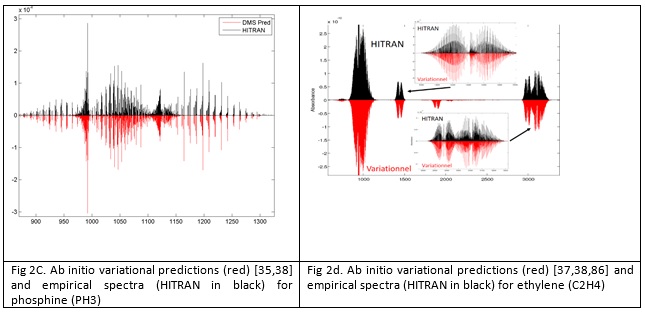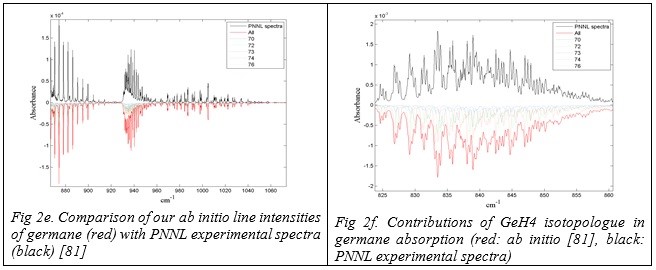Theoritical Molecular Physics and Modelisation
The PMT team develops interdisciplinary research activity focused on highly excited molecular states, quantum chemistry (ab initio) calculations, and theoretical spectra predictions with applications to their analyses, planetology, astrophysics, and dynamics.
A. AB INITIO POTENTIAL ENERGY SURFACES (PES), DIPOLE MOMENT SURFACES (DMS) AND NON-ADIABATIC (NAD) INTERACTIONS
Precise determination of these surfaces in a large range of energies and inter-nuclear configurations is of fundamental importance for interpretation of spectra and dynamics at various external conditions. For H3+ a very accurate (0.1 cm-1) global PES was generated. It includes Born-Oppenheimer energy, adiabatic, relativistic and Quantum-Electro-Dynamics corrections. Non-adiabatic shifts of rovibrational levels are described by finite mass approaches. The results describe the new high-resolution experimental data (10-4 cm-1) by J. T. Shy and make predictions accurate to 10-3 cm-1. To understand better the reaction H+ + H2 → H + H2+, which is non-adiabatic, we have computed non-adiabatic coupling terms between the four lowest singlet states. Non-adiabatic Jahn-Teller coupling and its effect on vibronic states of triplet H3+ has been investigated. Triplet H3+ may be considered a prototype molecule for the study of ozone. Finite mass approaches have also been used for the diatomic molecules H2, H2+ and LiH, for which benchmark computations of the vibrational states were performed. Collaborations [1-15]: P.Szalay, Budapest;. Polyansky, UK; J. Mohallem, Brazil; L.Adamowicz, USA; V. Kokoouline, USA.
A reliable description of the complicated shape of the ozone PES and that of the highly excited vibration states is of crucial importance for various unsolved issues in the spectroscopy and dynamics of ozone and remains a challenge for the theory. A breakthrough in ozone PES ab initio calculations has been achieved [16] (collaboration with P.Szalay, Budapest): extended electronic structure calculations were carried out enabling the determination of the parameters of our minimum energy path PES model resulting to a new set of theoretical vibrational levels of ozone.

A comparison with recent high-resolution spectroscopic data on the vibrational levels [17-31] of ozone gives the root-mean-square deviations below 1 cm-1, that represents an unprecedented ab initio accuracy for ozone band centres up to 93% of the dissociation energy and a significant improvement with respect to all previous calculations.
In close collaboration with A.Nikitin (Tomsk, Russia) ab initio PES and DMS recognised as currently most accurate available in the literature, were constructed for important hydrocarbons ( methane (CH4), ethylene (C2H4)), as well as for phosphine (PH3), silane (SiH4), germane (GeH4) and series of CH3X (X=F, I, Li, Br, Cl) molecules [32-38,81,83].
B. NEW THEORETICAL TOOL FOR GLOBAL PREDICTIONS, MODELING / ANALYSES OF VIBRATION-ROTATION MOLECULAR SPECTRA AND ISOTOPIC EFFECTS
The next step was the development of efficient theoretical methods [39-50] for global predictions of line positions and intensities approaching the spectroscopic accuracy for rotationally resolved spectra in a large wavenumber range from previously obtained PES and DMS (§A). A quite general algorithm of the variational method for solving stationary Schrödinger nuclear equation was implemented for semi-rigid molecules whatever the symmetry group [39-46]. This is based on an original reduction-compression technique both for the Hamiltonian model and the basis functions. A major advantage of our approach is the full account of all molecular symmetry properties for symmetric- and spherical-tops by means of irreducible tensor operators in first-principles spectra predictions. A systematic symmetry-based procedure for transforming a « mother » molecule to its isotopic species without any fitting procedure has been also developed [39-45]. All these tools are compiled into a general newly-developed computer code TENSOR for the construction of synthetic high-resolution spectra.
Starting from our recent methane ab initio surfaces considered as a benchmark in the literature, the absorption vibrational band of 12CH4 has been modeled and for the very first time, line positions and line intensities at 80 K and 296 K are shown to in very good agreement with raw experimental data from the ground vibrational state up to around 12000 cm-1. Our predictions led to the assignment of 108 new methane vibrational subbands in the highly congested Icosad 6280-7800 cm-1 range in Grenoble spectra [45-51].

Similar predictions permitted new assignments in 12CH4 and CH3D spectra [42-44] (collaborations in frame LIA SAMIA, ANR CH4@Titan and with JPL NASA [52-60]).
The same approach has been extended to other molecules like PH3, GeH4, CF4, C2H4 etc. Examples of the agreement for theoretically predicted and observed spectra for some of these species are given in Figs 2c-2f : an overview comparison for ab initio spectra of phosphine (PH3), germane (GeH4) and ethylene (12C2H4) with experimental bands included in HITRAN or PNNL databases.

For the first time variational predictions are in agreement of 1-3% in integrated band intensities [37] with experiment for six-atomics, but are much more complete. This will allow filling missing gaps for various applications.

An alternative method was implemented (MOL_CT code [48], collaboration with S.Tashkun, Tomsk) for accurate derivation of effective spectroscopic polyad models from molecular PES and DMS. This permitted assignment of many new bands of ozone isotopologues recorded in Reims (TF) and Grenoble (CRDS) [17-31] (ANR IDEO, collaboration with MSA, IOA Tomsk, LiPhy Grenoble).

In case of methane this resulted to a new “mixed model” combining advantages of ab initio information for resonance coupling terms and intensities with efficient empirical optimization for line positions [48].

Another research domain concerns electronic, vibrational and rotational structure of small molecules in external magnetic fields (collaboration A. Turbiner, Mexico)[9].
C. HIGH ENERGY MOLECULAR STATES NEAR AND ABOVE THE DISSOCIATION THRESHOLD
Accessing very highly excited molecular state is an new challenge for the theory and experience in various domains of sciences making an important link between quantum chemistry, spectroscopy, dynamics and radiative properties of high-temperature media ( § D).
Ozone in its excited quantum states and the related processes of ozone recombination remain a puzzle for the fundamental molecular physics. Since the discovery of anomalies in ozone isotope enrichment, several fundamental issues in the dynamics linked to the shape of the potential energy surface in the transition state (TS) region have been raised. The role of the “reef-like structure” on the minimum energy path is an intricate question previously discussed in context of chemical experiments. As a consequence of the hypothetical “reef” feature the calculated rate constants computed with previous PESs have been about 3–5 times smaller than measured ones and had wrong temperature dependence (ozone status report by R.Schinke et al ARPC, 2006). The analysis of the highly excited rovibrational states of ozone and its isotopic species near dissociation threshold (ANR IDEO) provided key insights for the validating the ozone PES and, in particular, the shape of the ozone TS [16,31]. The impact of the shape of the PES near the TS on vibration energy levels was studied for the first time. Analyses of 20000 rovibrational transitions of 6 ozone isotopic species have evidenced numerous irregular perturbations, confirming the key role of resonances in the dynamics of excited ozone.
Comparison of our theoretical predictions with assigned ultra-sensitive experiments [19-29] strongly suggests the absence of the submerged barrier at the dissociation ozone channel [31] bringing physical and chemical experiments in agreement. This has permitted resolving the controversial issue (existence or not of the “reef structure”) discussed in the literature during 20 years.
Using our ozone PES we have investigated the “doorway” dissociative states perturbing vibrionic CRDS spectra recorded in LiPhy (Grenoble) [20] and recently computed lifetimes of metastable vibrational states above the dissociation threshold (collaboration with UCF, Florida) [85] ( Figs 5-6) , that should have an impact on the ozone dynamics.



D. NEW THEORETICAL LINE LISTS FOR PLANETOLOGY AND ASTROPHYSICS APPLICATIONS AT VARIOUS TEMPERATURE CONDITIONS ( T= 80-2000 K )
Other applications concern emission/absorption properties of hot gazes. Using our PES [32] and new theoretical methods (§ B [48]) we have included very high energy ro-vibrational states approaching the dissociation threshold [61] to the calculation of the methane partition function Q(T) up to T=3000 K. Previous calculations were not sufficiently complete at high-T limit. The Q(T) function is necessary for characterization of thermodynamic properties, combustion and astrophysical applications of spectroscopy ( § D).
Among other hydrocarbons methane is one of the major absorbers in near-infrared (NIR) spectra and plays a central role in the radiative transfer and in the physical chemistry for various astrophysical objects with large ranges of effective temperatures Teff: from 80 K for giant planets or Titan’s atmosphere [62,63] up to around 3000 K for brown T/L dwarfs. Knowledge of intensities of rovibrational transitions of methane in a wide spectral range is thus essential for the modeling of various planetary atmospheres, brown dwarfs, and for other astrophysical applications.
Our work [46] has provided, for the very first time, a global theoretical line list for methane up to T = 2000 K containing 11.5 billion of lines. Comparisons with laboratory observations at T=1000 K ( Bernath et al 2015) showed that our prediction gave the best match with respect to all other calculations. Recently we investigated the extension of the study to higher temperature and/or wavenumber ranges up to 1 µm. To this end, careful convergence and intensity contributions for all hot bands is a big computational challenge.


A first theoretical global line lists of ethylene (12C2H4) spectra for the temperature range 50 - 700 K in the far-infrared for quantification of absorption and emission in planetary atmospheres has been computed [86]

INVITED RESEARCHES
Andrei Nikitin (Acad.Sci. Russia, Tomsk) , Peter Szalay (University of Budapest, Hungary) , Richard Daws (University of Missouri, USA), Sergei Tashkun (Acad.Sci. Russia, Tomsk), Evgeniya Starikova (Tomsk University. Russia), Semen Mikhailenko (Acad.Sci. Russia, Tomsk), H. Medel Cobaxin (Mexico), Alexaner Turbiner ( Mexico ), J. Mohallem (Brazil); Yuri Babikov (Tomsk University. Russia), Attila Tajti (University of Budapest, Hungary); Viatcheslav Kokoouline, ( University of Central Florida, USA).
International master student exchange:
A.Rodina, I. Chizhmakova ( Tomsk University)
RESEARCH PROJECTS
During last five years reported period the PMT team has contributed to the following projects:
1. ANR “CH4@Titan”(2009-2012) « Étude exhaustive de l’absorption du méthane dans l’atmosphère de Titan par le calcul et l’expérimentation » [Obs. Meudon, IC Dijon, LSP Grenoble, GSMA], PI: A.Coustenis, Coordinator GSMA: V.Tyuterev
2. ANR: projet “IDEO” (2009-2014) « Effets isotopiques et dynamiques dans l'ozone excité: brisure de symétrie, états d'énergie élevée et dissociation. [GSMA, LPS Grenoble, LPMAA Paris], PI: V.Tyuterev
3. European project VAMDC INFRA-2008-1.2.2 : (2009-2012) “Virtual Atomic and Molecular Data Centre”. Collaborative Project and Coordination and Support Action for ICT based e-Infrastructure (20 participants of 9 countries). PI : ML.Dubernet (LPMAA Paris), Coordinator GSMA: V.Tyuterev
4. GDRI France-Russie-Chine «SAMIA»(2009-2012) followed by LIA «SAMIA»(2014-2018) : «Spectroscopie d’Absorption de Molécules d’Intérêt Atmosphériques et planétologique ». PI France: A.Campargue (LPS Grenoble), Coordinator GSMA: V.Tyuterev
5. Projet Franco-Hongrois “Electronic structure calculations for BO breakdown in molecules with high nuclear permutational symmetry” dans le cadre du Programme bilatéral « Balaton » N° 27867WJ (Partenariat Hubert Curien), 2012-2013, PI : V.Tyuterev (France) and P.Szalay (Hungary)
6. Projet « Exploration du système de bandes inconnues du méthane isotopique dans la fenêtre de 2 microns pour l’interprétation des données des missions spatiales » PNP, Programme National de la Planétologie du CNRS, 2014-2016 (Reims / Observatoire de Meudon,). PI V.Tyuterev
7. Bilateral French( CNRS) / Mexica ( CONACyT) project, 2014,“Exact calculations for small molecules in external magnetic fields” . PI : A.Alijah (France) and A. Turbiner (Mexico)
8. French-Brezilian project “Sciences sans Frontières” (2014-2017) PI : A.Alijah (France) and J.Mohhalem (Brezil)
9. ANR: projet “e-PYTHEAS” (2009-2014) « Exo-planetary high-temperature hydrocarbons by emission and absorption spectroscopy”. [LESIA Meudon, GSMA, LPS Grenoble, LPMAA Paris, ICB Dijon ], PI: A.Coustenis, ccordinator for Reims: V.Tyuterev
During 2011-2016 the PMT team has published 86 papers in pear reviewed international journals including those of high IF as PRL, APJ, PCCP. With 75 presentations an International Colloquia and 6 invited plenary talks. 4 PhD theses have been successfully defended including 3 under international co-direction with Russia, Mexica and Brazil. The team has participated in the organization of international ASA/HITRAN workshop ( Reims 2012) and OZONE workshop (Reims 2013).
